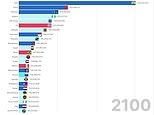China’s population will be more than halved by 2100, according to dramatic UN forecasts.
Startling projections suggest the economic superpower will be home to 634 million people by the end of the century, compared with 1.42 billion today.
China’s current population “disaster” has sparked panic around the world, with much of the world dependent on its massive manufacturing output.
Birth rates have plummeted to their lowest level on record, driven by a decades-long one-child policy. Beijing’s efforts in recent years to encourage women to have more children have failed.
MailOnline has today created a fascinating graphic showing the UN’s projections for each country’s population between now and 2100.
As well as capturing China’s decline, it shows how African nations such as the Democratic Republic of Congo and Angola are projected to quadruple in size.
Our fascinating time-lapse chart also reveals how each country’s population has changed since 1950, including the exact moment India overtook China to claim the title of the world’s most populous country (1.44b).
Between the two of them, they are home to more than a third of the world.
UN forecasts show that while India and China will likely hold the top spots for the next 76 years, the latter’s population will plummet to less than 1 billion by the late 2060s.
This would be equivalent to the Asian nation losing more population than the United States currently has in about 35 years.
It is estimated that by 2100 China will have lost more than 55 percent (almost 790 million) of its current population, leaving it at around 630 million.
Last year was the second year in a row that China’s population declined, driven by historically low birth rates driven by the country’s decades-long one-child policy.
While the limit was raised to two in 2015 and removed entirely in 2021, Beijing has failed to encourage women to have more children.
Experts have also blamed rising childcare costs and low wages for the failure to reverse the trend, despite extending maternity leave, offering tax breaks to large families and a crackdown on “non-medical” abortions – a move experts previously warned could endanger women’s lives.
President Xi Jinping’s final lifting of Covid restrictions was also partly blamed for death rates rising to a 50-year high.
India, on the other hand, will see its population grow until the early 2060s, reaching a peak of around 1.7 billion, before beginning to gradually decline (1.5 billion in 2100).
In the next two decades, Pakistan will overtake the United States and Indonesia to become the third most populous country in the world.
Pakistan’s population is projected to reach 385 million by 2053, compared with 383 million in the United States. Pakistan will have a population of 511 million by 2100.
The UK, currently ranked 21st with 67 million, is projected to drop out of the top 25 by the late 2040s, replaced by nations such as Kenya, Afghanistan and Sudan.
However, the population is still projected to reach 74 million by 2100, ranking 61st.
Meanwhile, the United States will fall from third to sixth place, with a population of 421 million by the turn of the century.
Falling fertility rates are the cause of the “underpopulation” crisis, which has Tesla billionaire Elon Musk seriously worried.
In 2017 he warned that the population “is accelerating towards collapse, but few seem to notice or care” and in 2021 he warned that civilization “would collapse” if people did not have more children.
Fertility rates are forecast to continue to fall in developed countries such as Britain and the United States, forcing them to rely more on immigration to support an ageing population.
Musk has claimed that Japan, which is seeing its population decline, could “completely disappear” if its low birth rates continue to decline and that Italy “will have no people” if current trends continue.
The ten countries that will experience the largest percentage of population growth are in sub-Saharan Africa, which will contribute almost 1 billion to population growth as a whole.
The world’s least populous countries – many of which are island states – are expected to remain largely stagnant.
The tiny Polynesian island of Niue had a population of fewer than 2,000 in 2023, the smallest of any nation in the world.
The UN predicts that Niue’s population will grow to just under 2,400 people by 2100.

